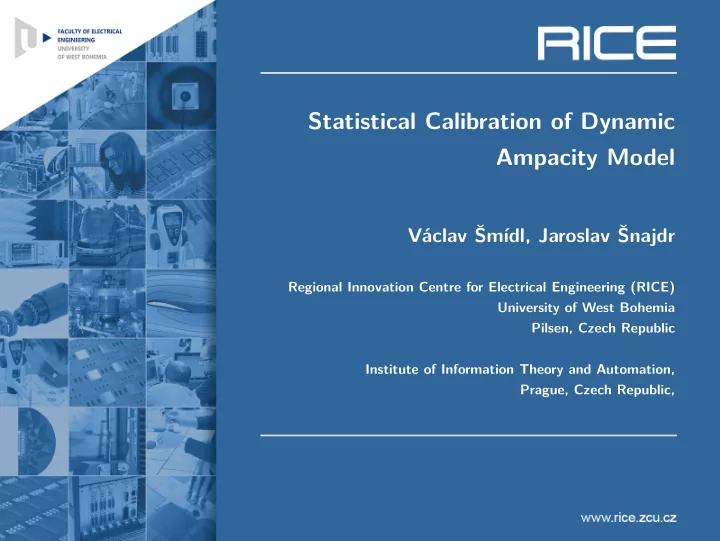

Statistical Calibration of Dynamic Ampacity Model Václav Šmídl, Jaroslav Šnajdr Regional Innovation Centre for Electrical Engineering (RICE) University of West Bohemia Pilsen, Czech Republic Institute of Information Theory and Automation, Prague, Czech Republic,
Outline Motivation Dynamic Ampacity Mathematical model Problem definition Proposed model Validation: real data � c
Ampacity = Ampere capacity of a conductor Limited by: 1. Conductor thermal limit 2. Minimal clearance of the ground Why it is important (VARLEY, J. 2009): 1. Demands for power transmission are unstable due to renewable sources, 2. Large safety margin on ampacity remains unused, 3. Too conservative limits on ampacity may yields energy money loss or stability problems. � c
CIGRE model of ampacity Model: dT c P J + P s + P c = m c c c dt + P r + P k + P w where: P J are Joule conductive losses, P J = RkI 2 ef [1 + b ( T c − 273)] , P s is solar heating, P s = ǫσ S ( T 4 amb ) c − T 4 P r is radiative cooling P c is convective cooling P k is corona heating P w is water cooling Properties ◮ complex non-linear model, ◮ uncertain inputs – weather conditions: solar, wind, rain � c
Experimental line Data from a line equipped by meteostations are available from ČEPS. Measurements (irregular sampling): ◮ solar radiation intensity, ◮ wind velocity and angle ◮ ambient and surface conductor temperature Solar activity 1400 1200 1000 800 600 400 200 0 −200 7.3466 7.3466 7.3466 7.3466 7.3466 7.3466 7.3466 7.3466 5 x 10 � c
Deterministic approach 80 Model Measurement 60 Conductor temperature [°C] Difference 40 20 0 − 20 00:00 06:00 12:00 18:00 00:00 time 1. The goal is to reach temperatures under a certain limit, ◮ errors can be used as safety margin 2. Errors are not constant, they are state dependent � c
Statistical approach Goals 1. Estimate not only the temperature but also the error bound. 2. Calibrate the error bound for reliability Challenges 1. quantify uncertainty of the inputs (how can we trust the sensors, potentially predictions) 2. transform the uncertainty through the non-linear model, 3. design model of corrections (callibration) � c
Proposed model 1. uncertainty of the inputs ◮ we operate on one hour window. Uncertainty is modeled by mean and variance of the values. 2. transform the uncertainty through the non-linear model, ◮ using sigma point transform on deterministic samples from the distribution of the inputs 3. design model of corrections (callibration) ◮ we estimate unknown multiplier, γ , of computed correlation cov( T c ) = γ cov( T c , model ) , � c
Validation: real data ritherm T calc 40 T calc std+ T calc std− T ritherm std+ 35 T ritherm std− ∆ opt 30 25 20 15 610 620 630 640 650 660 ritherm implicit T calc 55 T calc std+ T calc std− 50 T ritherm std+ 45 T ritherm std− 40 T [�C] 35 30 25 20 15 10 610 620 630 640 650 660 � c
Quantile-Quantile plot QQ Plot of Sample Data versus Standard Normal 1.5 1 0.5 Quantiles of Input Sample 0 −0.5 −1 −1.5 −2 −4 −3 −2 −1 0 1 2 3 4 Standard Normal Quantiles � c
Conclusion 1. Maximum current through a transmission line is restricted by thermal limit, 2. Temperature of the conductor depends on weather conditions, which are uncertain, 3. Statistical models calibration aims to provide reliable uncertainty bound 4. Future work: 4.1 design of model for predicted weather, 4.2 model local corrections, � c
Recommend
More recommend